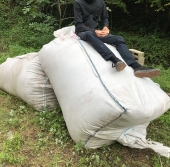
 4
4




 8
8




 1
1




Thom Bri wrote:Not 3 sisters related, but for years I have been collecting plastic containers that had plants in them. I never re-used them and I hardly ever start plants early and transplant.
Something happened in my brain this spring and now I have more seeds in pots than I have places to put them. The peppers pretty much ALL sprouted, three egg cartons worth. A dozen have been moved to pots.
Today I made a dozen more filled with several varieties of cantaloupes. Some seeds are fairly old, 2020, so I put lots of seeds in each little pot, hoping one or two will sprout. If many do I'll pinch the poorer-looking ones.
Next step is to figure out where to plant all these plants, assuming they grow.
I'm a market gardener in Wales, UK and live in the Radnor Hills. I live and work on land that is part of a rewilding farm owned by a Wildlife Trust. Loving my new polytunnel!
 3
3




Lisa Sture wrote:
Thom Bri wrote:Not 3 sisters related, but for years I have been collecting plastic containers that had plants in them. I never re-used them and I hardly ever start plants early and transplant.
Something happened in my brain this spring and now I have more seeds in pots than I have places to put them. The peppers pretty much ALL sprouted, three egg cartons worth. A dozen have been moved to pots.
Today I made a dozen more filled with several varieties of cantaloupes. Some seeds are fairly old, 2020, so I put lots of seeds in each little pot, hoping one or two will sprout. If many do I'll pinch the poorer-looking ones.
Next step is to figure out where to plant all these plants, assuming they grow.
Hi Thom
How did the 3 sisters go this year?
 5
5




 7
7




 6
6




 5
5




 6
6




 9
9




 8
8




 7
7




 7
7




 10
10




 5
5




 6
6




 8
8




 10
10




 12
12




 9
9




Zone 6, 45 inches precipitation, hard clay soil




 7
7




I do Celtic, fantasy, folk and shanty singing at Renaissance faires, fantasy festivals, pirate campouts, and other events in OR and WA, USA.
RionaTheSinger on youtube

 1
1




How Permies works: https://permies.com/wiki/34193/permies-works-links-threads
My projects on Skye: The tree field, Growing and landracing, perennial polycultures, "Don't dream it - be it! "
 6
6




Nancy Reading wrote:Thanks for the update Thom - lovely pictures of the garden, it really looks how I imagine! Pity about the squash bugs - we must have some threads on those....Do you eat the mallow? I gather it makes a good green vegetable or even salad.
 7
7




Riona Abhainn wrote: Almost all of my attempts at planting plants for autumn harvest were obliterated by the resident squirrel. I'd cook her and eat her if we lived farther out in the country, but since we're too close in I will settle for using that mesh netting for seeds next time.
 7
7




And I urge you to please notice when you are happy, and exclaim or murmur or think at some point, 'If this isn't nice, I don't know what is.'
-Kurt Vonnegut
 4
4




George Ingles wrote:
My observation is that Squash Bugs greatly favor the C. Maxima types (Hubbard, etc) and secondly go after C. Pepo 'Zucchini' types, and sometimes Cucumbers even.
They mainly don't bother the C. Moschata types (Butternuts, etc) and also don't bother the other sorts of C. Pepo in my garden.
I've considered abandoning C. Maxima (even though I've been trying to make a landrace).
Yet I wonder if I didn't grow it at all, would the Squash Bugs learn to favor the other Cucurbits?
 10
10




Zone 6, 45 inches precipitation, hard clay soil




 7
7




 6
6




 5
5




 1
1




I do Celtic, fantasy, folk and shanty singing at Renaissance faires, fantasy festivals, pirate campouts, and other events in OR and WA, USA.
RionaTheSinger on youtube

|
Brace yourself while corporate america tries to sell us its things. Some day they will chill and use tiny ads.
Learn Permaculture through a little hard work
https://wheaton-labs.com/bootcamp
|




